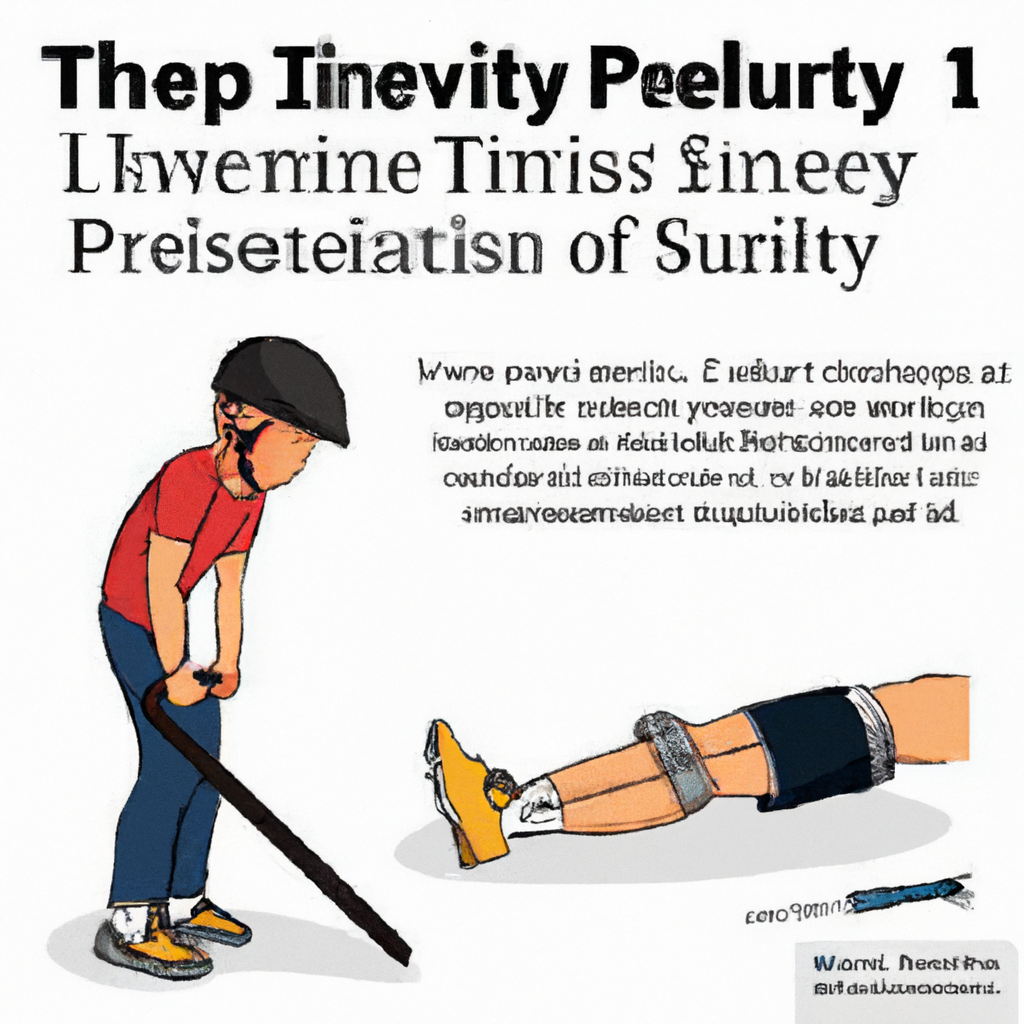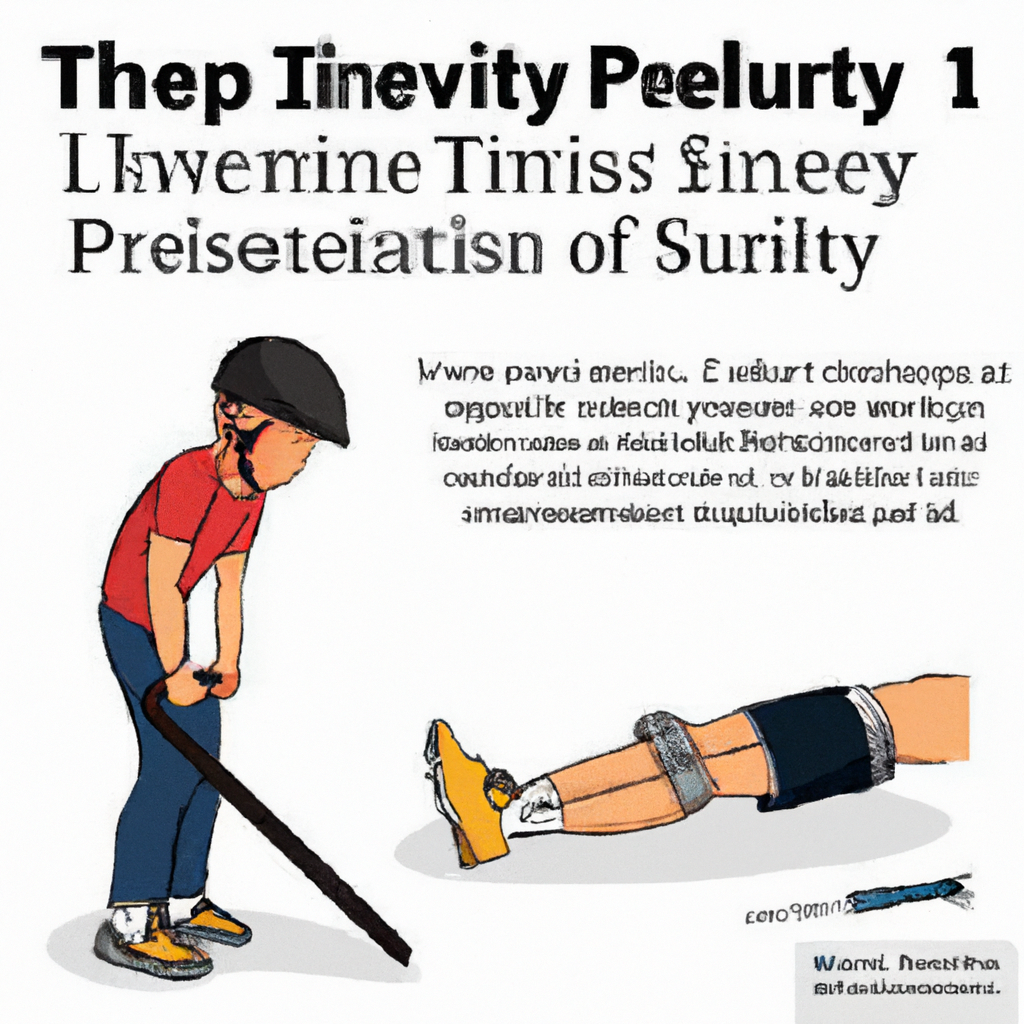Imagine living a life free from pain and injuries, where you are able to enjoy your favorite activities without worry. In this article, you will uncover 10 essential injury prevention tips that will not only help you avoid injuries but also aid in recovery and provide you with effective physical therapy exercises. By following these tips, you can ensure a healthier and happier lifestyle that allows you to fully embrace your passions. So, let’s dive in and discover the key to a safer and more fulfilling life.
10 Essential Injury Prevention Tips
Injury prevention is crucial for maintaining your overall health and well-being. Whether you’re an athlete, a fitness enthusiast, or simply someone looking to lead an active lifestyle, taking steps to prevent injuries is essential. By following these 10 essential injury prevention tips, you can minimize the risk of getting hurt and keep doing the activities you love.
1. Warm up before physical activity
1.1 Importance of warming up
Warming up before any physical activity is crucial for preparing your body for the demands it’s about to face. By gradually increasing your heart rate and blood flow, a warm-up helps loosen up your muscles and joints, reducing the risk of injuries like strains or sprains. It also prepares your mind, allowing you to mentally focus on the upcoming activity. Spending just a few minutes warming up can make a significant difference in preventing injuries.
1.2 Dynamic stretching exercises
Dynamic stretching exercises are an excellent way to loosen your muscles and increase your range of motion before physical activity. Unlike static stretching, which involves holding a stretched position for a prolonged period, dynamic stretches involve controlled, repetitive movements that mimic the activity you’re about to perform. Some examples of dynamic stretches include leg swings, arm circles, and walking lunges. Incorporating dynamic stretches into your warm-up routine can enhance your performance and reduce the risk of injuries.
1.3 Light aerobic exercises
In addition to dynamic stretching, engaging in light aerobic exercises during your warm-up can further prepare your body for physical activity. Activities like brisk walking, jogging, or cycling help increase your heart rate and blood flow, gradually raising your body temperature. This increased circulation delivers oxygen and nutrients to your muscles, promoting optimal performance and reducing the risk of muscle strains or tears. Including light aerobic exercises in your warm-up routine can significantly contribute to injury prevention.
2. Use proper equipment
2.1 Wearing appropriate footwear
Using the right footwear is essential for injury prevention, especially during activities that involve running, jumping, or high-impact movements. Properly fitting shoes with adequate cushioning and support help absorb shock and reduce the stress placed on your joints. They also provide better stability and alignment, minimizing the risk of ankle sprains, shin splints, or stress fractures. Choosing shoes specifically designed for your activity and replacing them when they show signs of wear and tear will go a long way in preventing injuries.
2.2 Protective gear for specific activities
Certain activities require additional protective gear to ensure your safety. For example, wearing a helmet is crucial during bike rides or contact sports like football or hockey to minimize the risk of head injuries. Knee pads, elbow pads, and wrist guards are essential for activities like skateboarding, rollerblading, or even certain fitness classes. Always make sure to use the appropriate protective gear for the activity you’re engaging in to prevent any avoidable injuries.
2.3 Ensuring equipment is well-maintained
Using well-maintained equipment is just as important as using the right equipment. Regularly inspect your gear, whether it’s sporting equipment, exercise machines, or even your yoga mat, to ensure they are in good condition. Check for any signs of wear, such as loose screws, frayed cables, or cracked surfaces. Keeping your equipment in optimal working condition helps prevent accidents caused by equipment failure and reduces the risk of injuries.

This image is property of images.pexels.com.
3. Practice good technique
3.1 Proper form and posture
Practicing good technique is vital for injury prevention, regardless of the activity you’re performing. Whether it’s lifting weights, throwing a ball, or doing yoga poses, using proper form and maintaining correct posture not only enhances your performance but also reduces the risk of injuries. Improper form can place excessive strain on your muscles, joints, and ligaments, leading to sprains, strains, or even more severe injuries. Take the time to learn and practice the correct technique for your activities to ensure a safe and effective workout.
3.2 Understanding movement mechanics
Understanding the mechanics of the movements you perform is crucial for injury prevention. Knowing how your body moves and the forces involved in each activity can help you make better decisions about how to engage in them safely. For example, knowing the proper technique for lifting heavy weights can protect your back from strain or injury. Educate yourself about the biomechanics of your chosen activities to reduce the risk of injuries and maximize your performance.
3.3 Seeking professional guidance
When in doubt about proper technique or movement mechanics, seeking professional guidance can be incredibly beneficial. Trained professionals such as coaches, trainers, or physical therapists can provide valuable insight and instruction tailored to your specific needs. They can assess your form, identify any areas of weakness, and provide corrective exercises or modifications to minimize the risk of injuries. Investing in professional guidance can significantly enhance your performance while reducing the likelihood of sustaining injuries.
4. Listen to your body
4.1 Recognizing warning signs of injury
Listening to your body and recognizing the warning signs of potential injuries is crucial for injury prevention. Pain, discomfort, swelling, or limited range of motion are all warning signs that something may be wrong. Ignoring these signs and pushing through the pain can exacerbate existing injuries or lead to new ones. Pay attention to your body’s signals and take action to address any discomfort or pain promptly to prevent further damage.
4.2 Taking breaks when necessary
Taking breaks and allowing your body to rest is essential for injury prevention. Overworking your muscles or engaging in repetitive activities without rest can lead to overuse injuries. These injuries occur when the muscles, tendons, or joints are subjected to excessive stress without adequate time to recover. Incorporating rest periods into your routine and listening to your body’s fatigue signals can help prevent overuse injuries and promote optimal recovery.
4.3 Modifying activities as needed
Being flexible and willing to modify your activities when necessary is crucial for injury prevention. If you’re experiencing pain or discomfort during a specific exercise or activity, consider finding alternative movements that don’t aggravate the area. For example, if your knee is bothering you during a high-impact workout, try switching to a low-impact option like swimming or cycling. Making appropriate modifications allows you to continue being active while reducing the risk of further injury.

This image is property of images.pexels.com.
5. Maintain a balanced diet
5.1 Importance of adequate nutrition
Maintaining a balanced diet is essential for injury prevention and recovery. Proper nutrition provides your body with the necessary nutrients to support optimal health and healing. Consuming a diet rich in fruits, vegetables, whole grains, lean proteins, and healthy fats ensures that your body receives an adequate supply of vitamins, minerals, antioxidants, and macronutrients. These nutrients play vital roles in tissue repair, immune function, and overall well-being, reducing the risk of injuries and promoting faster recovery.
5.2 Consuming a variety of nutrients
To ensure you receive a wide range of nutrients, aim to eat a variety of foods from different food groups. Each food group provides unique benefits and nutrients that contribute to your overall health. For example, fruits and vegetables are rich in vitamins, minerals, and fiber, while lean proteins provide essential amino acids for tissue repair. Incorporating a variety of nutrient-dense foods into your diet helps maintain a balanced nutrient intake, supporting injury prevention and recovery.
5.3 Incorporating protein-rich foods
Protein plays a critical role in injury prevention and recovery as it provides the building blocks for muscle repair and growth. Including protein-rich foods in each meal and snack helps ensure an adequate intake throughout the day. Good sources of protein include lean meats, poultry, fish, eggs, dairy products, legumes, and plant-based proteins like tofu or tempeh. Aim to consume a balanced amount of protein with each meal to support your body’s recovery and reduce the risk of muscle-related injuries.
6. Stay hydrated
6.1 Benefits of proper hydration
Staying properly hydrated is crucial for supporting your body’s functions and preventing injuries. Water is essential for maintaining optimal joint lubrication, facilitating nutrient transport, regulating body temperature, and promoting overall physiological balance. Dehydration can lead to muscle cramps, fatigue, dizziness, and impaired cognitive function, all of which increase the risk of accidents or injuries. Drinking an adequate amount of water throughout the day helps ensure optimal hydration and reduces the risk of dehydration-related injuries.
6.2 Fluid intake recommendations
The amount of fluid you need to consume depends on various factors, including your body size, activity level, and environmental conditions. As a general guideline, aim to drink at least eight cups (64 ounces) of water per day. However, during intense physical activity or in hot weather, you may need to increase your fluid intake to compensate for the additional fluid loss through sweat. Listen to your body’s thirst signals and drink water regularly to stay properly hydrated and prevent dehydration-related injuries.
6.3 Electrolyte replacement
In addition to water, electrolytes play a vital role in maintaining proper hydration and preventing injuries. Electrolytes are minerals that help maintain fluid balance, regulate muscle contractions, and support nerve function. When you sweat, you lose electrolytes along with water. Replenishing these electrolytes, such as sodium, potassium, magnesium, and calcium, is important to maintain balance and prevent dehydration-related cramps or fatigue. You can replace electrolytes through sports drinks, electrolyte tablets, or consuming foods rich in electrolytes, such as bananas or coconut water.

This image is property of images.pexels.com.
7. Get enough rest
7.1 Importance of sleep for recovery
Getting adequate sleep is crucial for injury prevention and recovery. During sleep, your body undergoes various essential processes, including tissue repair, muscle growth, and hormone production. Lack of sleep can impair these processes, compromising your body’s ability to heal and recover from physical activity. Aim to get 7-9 hours of quality sleep each night to optimize recovery, reduce the risk of injuries, and ensure your body is ready for the stress of daily activities.
7.2 Establishing a sleep routine
Establishing a consistent sleep routine helps regulate your body’s internal clock and promotes better sleep quality. Try going to bed and waking up at the same time each day, even on weekends. Create a relaxing pre-sleep routine, such as reading a book, taking a warm bath, or practicing relaxation techniques, to signal your body that it’s time to wind down. Minimize exposure to electronic devices, caffeine, and stimulating activities close to bedtime to ensure a restful night’s sleep.
7.3 Strategies for quality sleep
In addition to establishing a sleep routine, there are several strategies to improve the quality of your sleep. Create a comfortable sleep environment by keeping your bedroom cool, dark, and quiet. Invest in a supportive mattress and pillows that suit your needs. Limit daytime napping to avoid interfering with nighttime sleep. Engage in regular physical activity, but avoid intense workouts close to bedtime. Managing stress through relaxation techniques like deep breathing or meditation can also contribute to better sleep quality. Prioritize quality sleep for optimal injury prevention and recovery.
8. Gradually increase intensity and duration
8.1 Progressive overload principle
When engaging in physical activity, it’s crucial to gradually increase the intensity and duration over time. The principle of progressive overload involves gradually challenging your body and giving it time to adapt to increasing demands. Pushing too hard, too soon can lead to overuse injuries, muscle strains, or other adverse effects. Whether you’re starting a new exercise program or progressing to more challenging workouts, take incremental steps and allow your body to adjust to the increased workload gradually.
8.2 Setting realistic goals
Setting realistic and achievable goals is essential for injury prevention. Understand and respect your body’s current capabilities and limitations. While it’s great to challenge yourself, be mindful of your body’s signals and avoid pushing beyond your limits. Setting attainable short-term and long-term goals promotes a sense of accomplishment while reducing the risk of overexertion or injury. Remember that progress takes time, and consistent effort is more sustainable and safe than trying to achieve rapid results.
8.3 Monitoring and adjusting workload
Monitoring your body’s response to physical activity and adjusting your workload accordingly is crucial for injury prevention. Pay attention to how your muscles, joints, and overall energy levels feel during and after exercise. Gradually increase your workload, such as weight lifted or distance covered, as long as you feel comfortable and without any pain or discomfort. If you experience persistent pain, fatigue, or reduced performance, consider scaling back your workouts or seeking professional guidance. Regularly assessing and adjusting your workload helps prevent overuse injuries and promotes continuous progress.

9. Avoid overtraining
While it’s important to challenge yourself and work towards your goals, it’s equally crucial to avoid overtraining. Overtraining occurs when you exceed your body’s capacity to recover from the stress of exercise. Signs of overtraining include persistent fatigue, decreased performance, mood disturbances, or an increased frequency of injuries. To prevent overtraining, incorporate rest days into your routine, vary the intensity and duration of your workouts, and prioritize recovery strategies such as quality sleep, proper nutrition, and stress management. Finding a balance between pushing yourself and allowing your body to recover is key to injury prevention.
10. Follow a comprehensive exercise program
10.1 Consistency in training
Consistency is key in injury prevention and achieving long-term fitness goals. Following a comprehensive exercise program that suits your needs, preferences, and current fitness level helps ensure consistent and safe progress. Consistency allows your body to adapt to the demands of exercise, reducing the risk of injuries. Whether you’re following a structured program or designing your own, prioritize regular exercise sessions and make them a part of your daily or weekly routine.
10.2 Incorporating variety and cross-training
In addition to consistency, incorporating variety and cross-training into your exercise program is essential for injury prevention. Performing a variety of exercises and engaging in different activities helps develop well-rounded strength, flexibility, and cardiovascular fitness. It also reduces the risk of overuse injuries associated with repetitive movements. Incorporate activities such as strength training, cardio workouts, flexibility training, and recreational activities to keep your workouts exciting and prevent muscle imbalances or overuse injuries.
10.3 Seeking professional guidance
If you’re new to exercise or unsure how to structure your workouts effectively, seeking professional guidance can be immensely helpful. Personal trainers, fitness coaches, or physical therapists can help assess your goals, fitness level, and any specific needs or limitations you may have. They can create a personalized exercise program tailored to your objectives and guide you through proper form, technique, and progressions. Professional guidance ensures that you’re following a safe and effective exercise program, minimizing the risk of injuries and maximizing your results.
By following these comprehensive injury prevention tips, you can take proactive steps to protect your body, reduce the risk of injuries, and enhance your overall physical well-being. Incorporate these practices into your routine and enjoy the benefits of a safe, enjoyable, and sustainable active lifestyle. Remember, prevention is always better than cure, so prioritize injury prevention to keep doing the activities you love for years to come.






